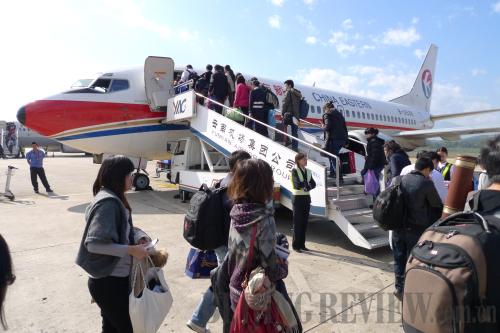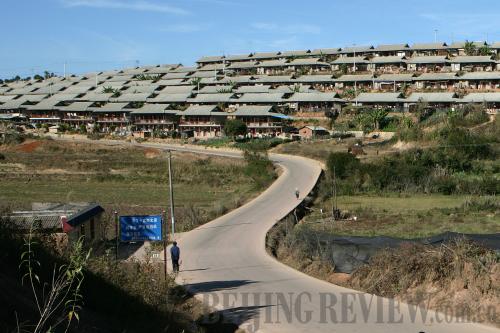|
 |
|
FREQUENT FLIERS: Passengers queue to board an aircraft at Kunming Wujiaba Airport. The airport has seen renewed growth in recent years as part of the Western Development Strategy (WANG XIANG) |
China's vast western region covers nearly two thirds of the country and boasts the country's longest border. As the most secluded area, the western region lagged behind China's prosperous eastern coastal area in social and economic development.
At the dawn of the new century, the Central Government formulated a plan of strategic importance, kicking off the Western Development campaign to facilitate development in west China. According to the blueprint, while implementing the plan, local governments should give priority to eco-system protection, focus on improving infrastructure, adjust the structure of local industrial sectors and cultivate certain industries that will improve the people's livelihood, education and overall welfare.
Under the framework, a number of pilot engineering projects, such as the West-to-East natural gas and power transmission projects, have been completed in the past 10 years. During that same period, local governments launched major irrigation, energy and communications projects, beefed up eco-system protection efforts, improved local residents' livelihoods, encouraged local industries to develop faster, and pushed through a new set of policies for reform and opening up.
After a decade's development, all kinds of economic indicators showed that the western region's economy was growing faster than the central and eastern areas, allowing the western region to become a new growth point in China's economy.
 |
|
ROAD TO PROSPERITY: A cement-paved road links Longlong Village in Yunnan Province to the outside world (WANG XIANG) |
Kunming Wujiaba Airport in southwest China's Yunnan Province is no strange name to veterans and enthusiasts of the Flying Tigers, the famed volunteer force of U.S. pilots who fought in China at the start of World War II. At its peak, two planes took off or landed at the airport every minute.
After World War II, Wujiaba Airport's fame declined and all but disappeared. Although business improved slightly after the founding of the People's Republic of China in 1949, the airport failed to regain its former glory until 2001.
Ni Hong, a Yunnan civil aviation official, said that a number of reforms to Yunnan's civil aviation sector have been implemented since 2001, allowing Kunming Wujiaba Airport to rise in rank to the seventh largest airport in China in terms of passenger turnover in 2005.
Currently, the airport is unable to meet transportation needs for air carriers—many flights are forced to hover over the airport prior to their scheduled landing. The Kunming Municipal Government is investing 23.4 billion yuan ($3.43 billion) toward the construction of a new airport to ease pressures on Wujiaba Airport, while the latter is undergoing a capacity expansion project expected to be completed by 2012, Ni said.
Kunming Wujiaba Airport is just one of the many success stories owing to the rapid development across China's west in the past decade.
The Western Development endeavor covers Chongqing Municipality, Sichuan, Guizhou, Yunnan, Shaanxi, Guansu and Qinghai provinces, and Tibet, Ningxia Hui, Xinjiang Uygur, Inner Mongolia and Guangxi Zhuang autonomous regions. The campaign benefits more than 70 percent of the country's total territory, and about 30 percent of its total population.
| 